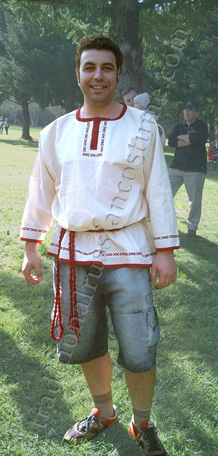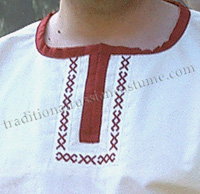
| Outfits >>> Replicas >>> Go-to-meeting shirt for a married man | ||

|
| |
|
A person ordered this model requested: "I want to have a Russian peasant's shirt. It should be fancy enough, to be appropriate to attend events of a Kedry club. At the same time, I want to wear it at the office sometimes, so it should be modest". The only one model of a man's shirt meets such a requirements: a go-to-meeting shirt for a married man from Kargopol district (Northern Russia). This shirt is of an archaic chiton-like design. It is the most common for Slavic and Russian shirts. The cut is: a rectangular piece of cloth is folded half-by-half across a warp (along a woof). On the fold line they make an oval hole for a neck, and a long cut on a front part of a shirt. Shirts with a cut on the left (or sometimes on the right) side (so-called kosovorotka) appeared not earlier than the 16th century, and as a peasants' design only (more info >>>>>).
As a tradition required, all edges of this shirt protected with a red "fire line". The protection is doubled by the embroidery that runs parallel to a red line. The design used here is a mix of a very formalized Sun Wheel and a symbol of The Mother Earth. So, the wearer gets a protection of two main powers of a Russian pagan pantheon. The shirt is made of a creamish-white cloth that remains linen. A color emphasizes an archaic fashion and decoration. Also, it pinpoints that the wearer is a married man. A young bachelor should dress himself as bright and fancy as possible, to demonstrate a surplus of his vital energy. And a married man's costume should be made of a modest-colored but expensive fabrics of a high quality. Such a style reflected a high social status of a respectful and succesful businessman. | ||
Sources (in Russian)
| ||
